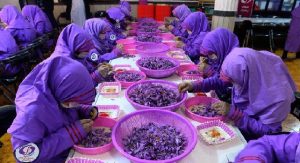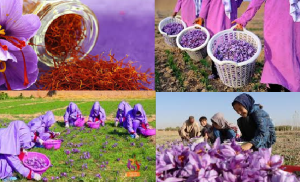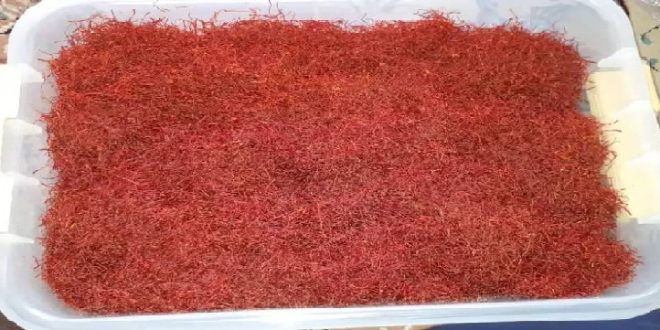09-06-2024
KABUL: Officials from the Ministry of Agriculture, Irrigation, and Livestock say that Afghanistan, the world’s second-largest saffron producer, is expected to harvest nearly fifty tons of saffron this year.
Sadr Azam Osmani, Deputy Minister of Agriculture, Irrigation, and Livestock, said: “Afghan products have their own standards in the world, but this is the ninth time that Afghan saffron has secured the first position.”
 According to the ministry, saffron is cultivated in twenty-six provinces of the country, but nearly 90 percent of the country’s saffron is harvested in Herat.
According to the ministry, saffron is cultivated in twenty-six provinces of the country, but nearly 90 percent of the country’s saffron is harvested in Herat.
A Herat-based export company represented Afghanistan in this competition.
Najibullah Rahmati, the head of the saffron export company, said: “We have been working on this for several years with farmers, processors, and on how to dry it properly, and today we have seen the results.”
In the past year, Afghanistan exported nearly thirty tons of saffron worth thirty-five million dollars to India, Saudi Arabia, and several other countries. Currently, the price of each kilogram of saffron in domestic markets is up to 120,000 Afghani.
Mohammad Ibrahim Adel, head of the Afghan Saffron Association, said: “A total of 29,570 kilograms of saffron have been exported in the past eight months to countries like India, Spain, and Saudi Arabia.”
According to predictions by the Ministry of Agriculture, Irrigation, and Livestock, the saffron harvest in Herat is expected to increase to fifty tons this year.
Last year, nearly thirty tons of saffron were harvested in Herat. This year, over eight thousand hectares of land in Herat are being used to grow saffron.
Akhundzada Abdul Salam Jawad, the spokesperson for the ministry, said that the saffron was exported to India, the United Arab Emirates, Spain, Saudi Arabia, the USA, Indonesia, Turkey, and the UK.
 Saffron, a major export commodity for Afghanistan, is predominantly cultivated in the provinces of Herat, Balkh, Kandahar, Sar-e Pol, Daikundi, and Uruzgan. Notably, saffron from Herat is renowned for its superior quality and robust presence in the global market.The National Saffron Workers Union (NSWU) stated that the cost of transporting saffron abroad is high and that attention must be paid to reducing prices.
Saffron, a major export commodity for Afghanistan, is predominantly cultivated in the provinces of Herat, Balkh, Kandahar, Sar-e Pol, Daikundi, and Uruzgan. Notably, saffron from Herat is renowned for its superior quality and robust presence in the global market.The National Saffron Workers Union (NSWU) stated that the cost of transporting saffron abroad is high and that attention must be paid to reducing prices.
Nasir Ahmad Nabil, a member of NSWU, said: “The few problems we have are related to transportation; previously, we used cargo services through tanneries, which provided more convenience in transportation. We have shared these issues and hope they will be addressed.”
Arbab Abdul Razaq Pashtun Zarghuni, the foreign relations officer of the NSWU, also said: “Cooperation with farmers and companies should be enhanced, and tariffs in the sector should be reduced. If tariffs are not lowered, we will be forced to increase our fees, which could result in losing customers to our competitors. Serious attention is needed in this area to retain our customers against competition.”
The Ministry of Agriculture, Irrigation, and Livestock reports that in the solar year 1402, over 23,000 metric tons of saffron were harvested across 26 provinces of the country. “In 26 provinces, saffron was cultivated on 8,304 Jeribs (approx. 4,209 acres) of agricultural land, yielding approximately 23,249 metric tons of saffron,” said Musbahuddin Mustaeen, a spokesman for the ministry.
The Chamber of Commerce and Investment also emphasizes support for saffron products and the creation of exhibitions to further market them.
Maiwand Hotak, the head of the executive board of the Chamber of Commerce and Investment, said: “A better understanding should be signed to facilitate the saffron process in Afghanistan and find the best markets in other countries as well.” (Int’l News Desk)
 Pressmediaofindia
Pressmediaofindia




